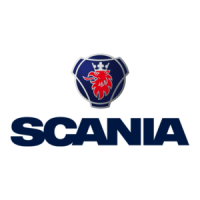8 © Scania Industrial & Marine Engines 2003-10:1
Safety precautions for handling
materials
Fuel and oil
All fuels and lubricants and many chemicals are
inflammable. Always follow the instructions on
the relevant packaging.
All work on the fuel system must be done with
the engine cold. Fuel leaks and spillage on hot
surfaces can cause fire.
Store soaked rags and other inflammable
materials safely so as to avoid spontaneous
combustion.
Batteries
The batteries contain and emit oxyhydrogen
gas, particularly during charging, and this gas is
inflammable and highly explosive. Therefore,
there must be no smoking, naked flames or
sparks near the batteries or the battery
compartment.
Incorrect connection of a battery cable or jump
lead can cause a spark, which in turn can
cause the battery to explode.
Chemicals
Most chemicals such as glycol, corrosion
inhibitor, inhibiting oils, degreasing agents, etc.
are hazardous to health. Always follow the
safety precautions on the relevant packaging.
Some chemicals, such as inhibiting oil, are also
inflammable.
Store chemicals and other materials which are
hazardous to health in approved containers,
marking them clearly and storing them where
they are inaccessible to unauthorised persons.
Always hand in leftover or used chemicals to an
authorised waste disposal contractor.
Safety precautions for care and
maintenance
Stop the engine
Always stop the engine before maintenance
and servicing unless stated otherwise.
Prevent unwanted starting by taking out the
ignition key where applicable and
disconnecting the power using the master
switch or battery master switch and locking
them. Also put up a warning sign somewhere
appropriate, indicating that work is in progress
on the engine.
Working with a running engine always poses a
safety risk. Parts of the body, clothes or
dropped tools can get caught in rotating parts
and cause injury.
Hot surfaces and fluids
There is always a risk of sustaining burns when
an engine is hot. Therefore, take care not to
come into contact with manifolds, the turbo, the
sump, hot coolant and oil in pipes and hoses.
Lifting the engine
The engine lifting eyes must be used when
lifting the engine. Check first that your lifting
devices are in good condition and of the correct
size to lift the weight.
Extra equipment on the engine can alter the
centre of gravity, which is why you may need
additional lifting devices to balance the engine
correctly and lift it safely.
Never work underneath a suspended
engine!

